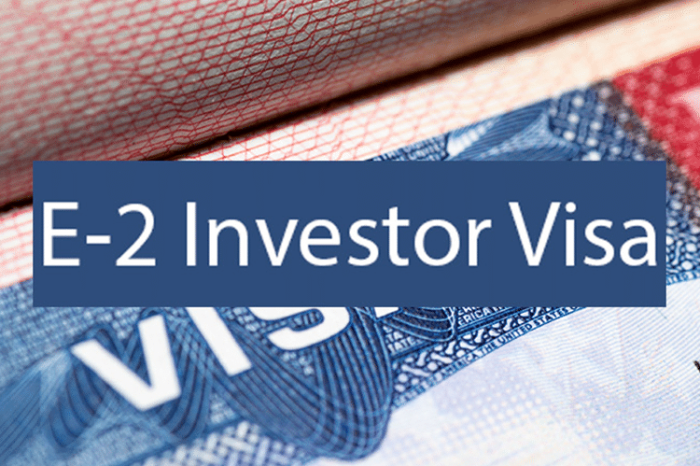Are you an investor? If yes, you probably are interested in investing in the US but wondering whether it is possible to get a visa on this basis. Of course, the answer is “YES.” The USCIS allows an investor from a treaty country to come to the US, invest their money in a business enterprise, and provide them with an E-2 visa. This article deals with an overview of an E-2 visa and some popular questions related to it.
TABLE OF CONTENT
2. Who can apply for an E-2 visa?
3. What are the criteria to be an E-2 investor?
4. What is a substantial investment?
5. What are the criteria for an employee to be eligible for an E-2 visa?
6. What is the period of stay on an E-2 visa?
7. What are the terms and conditions to maintain an E-2 visa?
8. How can a treaty investor or an employee apply for an E-2 visa?
1. What is an E-2 visa?
An E-2 Visa is a nonimmigrant visa for foreign nationals who invest substantial capital in a US business. Also, employees of such individuals or a qualifying organization can apply for this visa. In addition, dependants of the investor or an employee can accompany them as E-2 nonimmigrant dependent category.
2. Who can apply for an E-2 Visa?
The foreign nationals who are eligible for E-2 Visa are:
• Foreign nationals of a country with which the United States maintains a treaty of commerce and navigation.
• Foreign nationals with which the United States maintains an international qualifying agreement.
• Foreign nationals from a country deemed to be a qualifying country by the US legislation.
You can find the list of countries with which the US maintains a treaty of commerce and navigation here
3. What is the criteria to be an E-2 investor?
1. The critical requirement to be an E-2 visa holder is to be a national from a treaty country, as discussed above. It is not vital that you are currently residing in the treaty country; however, you must show that you are a country citizen.
2. The investment by the E-2 treaty investor must be substantial. That means it must satisfy the definition of significant by USCIS, which is discussed later in this article. A treaty investor can use financial documents, business plans, or a bank statement as evidence to show USCIS that the investment is substantial.
3. The E-2 investor’s investment must be placed to earn a desired profit in the future for the business. That means the risk of losing the capital in case things take a u-turn should be there. The USCIS will not consider the application if the treaty investor can back out if things do not go well. The E-2 treaty investor should prove that the investment is bona fide earnings of him or obtained from a legal route, and there is no illegal activity involved in getting such funds.
4. The E-2 investor should not invest in a marginal enterprise. A marginal enterprise does not possess the ability to generate sufficient profits to support the living of the treaty investor or his family. However, a new enterprise gets immunity if it fails to create such funds because it is newly established.
5. The treaty investor must show his intention to develop and direct the enterprise if he is coming to the US on an E-2 Visa. There are criteria defined by USCIS to prove his intention. He must either be able to demonstrate a minimum of 50% of the ownership of the enterprise or be able to establish control over operations of the enterprise through a managerial position or other corporate devices.
4. What is a substantial investment?
USCIS defines substantial as in:
1. Considerable enough to tell on its face a treaty investor’s financial commitment to make the business successful.
2. For an enterprise with a low-cost business, the percentage of investment should be high to be considered a substantial investment. In contrast, for a high-cost business enterprise, the investment portion can be comparatively low to be deemed significant.
5. What are the criteria for an employee to be eligible for an E-2 visa?
1. The employee should be a national from the treaty country his principal investor belongs to.
2. He should fulfill all the requirements under the definition of “employee” under the US code.
3. The treaty investor or qualifying organization must hire the employee in a prominent position in the success of the treaty investor’s venture. That position could be of an executive or a manager or any other position of a supervisory character. Or, even if an employee possesses the specialized skills required for the growth and development of the enterprise, he may be employed for a lesser capacity than an executive role.
6. What is the period of stay on an E-2 visa?
An E-2 visa falls under the category of nonimmigrant visa and is issued for a temporary period. The treaty investor or the employee can enter the US and stay for a maximum of 2 years. However, they can apply for an extension of their status if they qualify under the E-2 category after the 2-year expiration. Once USCIS approves the extension petition, the extension is granted in increments of up to 2 years each. The advantage for the E-2 visa holder is that they can apply for the extension infinite times if they fulfill its requirements.
7. What are the terms and conditions to maintain an E-2 visa?
The treaty investor or an employee having E-2 status is only allowed to operate in the business enterprise/occupation that USCIS authorized when granting them the E-2 visa. Though the employee may also serve the treaty organization’s parent company or its subsidiary if the relationship between these organizations is established, there is no alteration to the terms and conditions of the employment.
If there is any material change in the firm’s business or the nature of the employee’s job, the treaty investor must inform about these changes to USCIS by filing Form-129. USCIS will then determine if the treaty investor or the employee qualifies for E-2 classification after such material changes. Such material changes could be a merger or acquisition, or sale of a division of the business enterprise.
The treaty investor or the employee must maintain their intention to depart from the US while on E-2 visa classification.
8. How can a treaty investor or an employee apply for an E-2 Visa?
To apply for an E-2 visa, the location of the person applying affects the mode of application.
1. If the treaty investor is currently in the US on any other lawful immigration status, he can file Form-129 to request USCIS to change his other nonimmigrant visa to E-2 classification. Likewise, in the case of an employee in the United States on any other lawful nonimmigrant visa, his qualifying employer may file Form I-129 to request a change of his status to the E-2 category.
2. If the treaty investor or an employee is outside the US, he may check the US department of state website for more information on applying for E-2 classification. The steps may vary at the US embassy or consulate where they are applying. First, however, they need to file Form DS-160, an online nonimmigrant visa application form for temporary travel to the US.
Conclusion
Since you know a lot about E-2 visas, probably someday you might be coming to the US as an investor. However, if you still have any queries, our legal experts will be delighted to help you.








 by Prozco®
by Prozco®